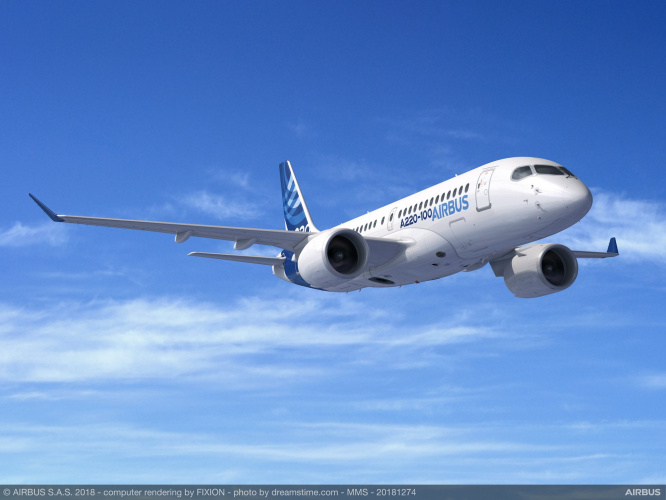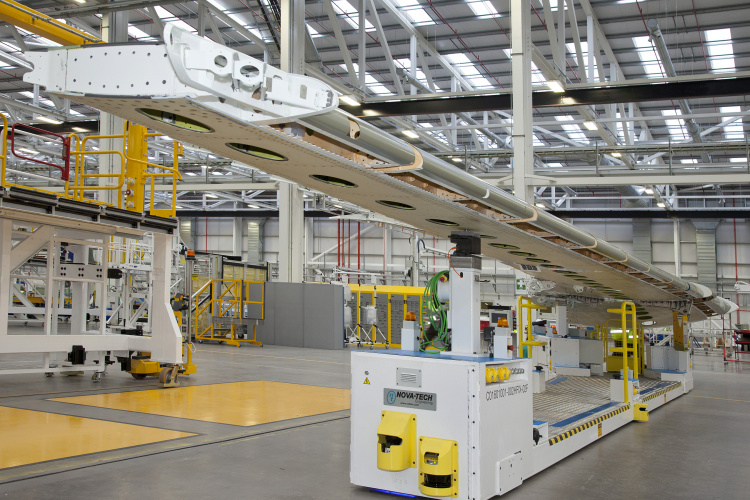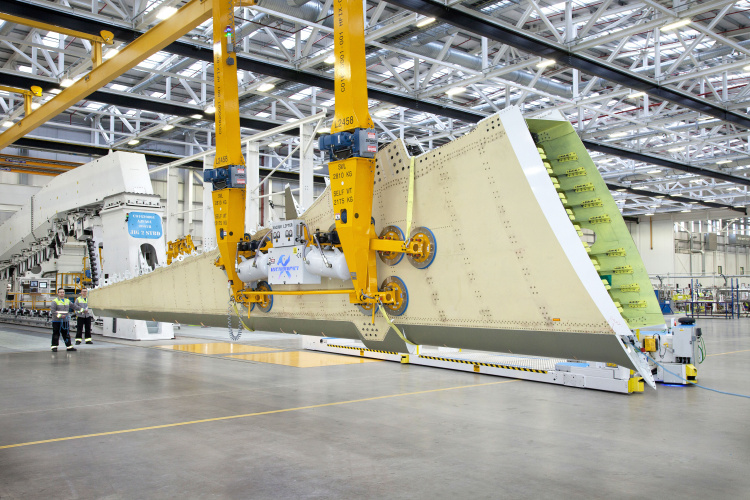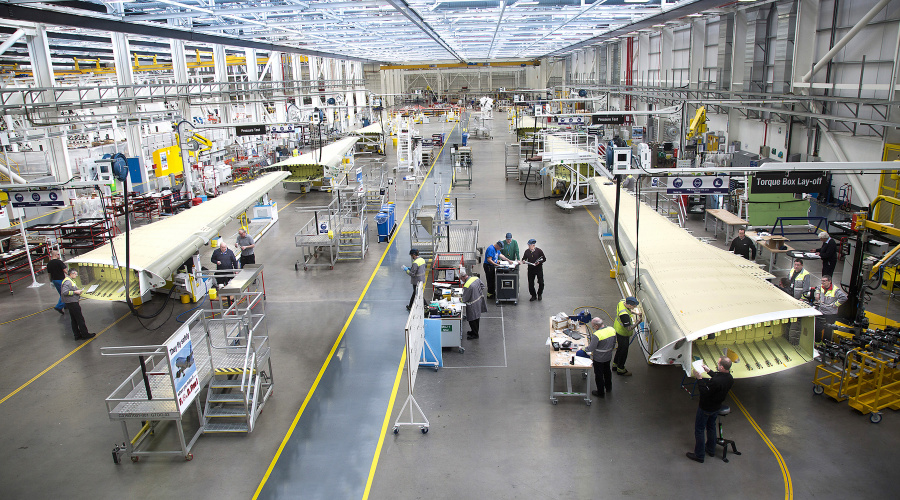
It’s almost a cliché to say that commercial aircraft don’t look much different now than they did two decades ago. But get below the skin and they have changed beyond all recognition. And little demonstrates this better than the wings of the Airbus A220, the small airliner that began its existence as the Bombardier C series. Although outwardly there is little to distinguish them from the wings of any other small airliner, they are so radically different from conventional wings they required the adoption of an entirely new design and manufacturing philosophy and the construction of a purpose-built factory at Bombardier’s historic Belfast site.
It was these radical differences that led to the wing being selected as the winner of the 2019 MacRobert Award, the highest honour awarded to an engineering project by the Royal Academy of Engineering. Previous winners include the Pegasus jet engine that powered the Harrier, catalytic converters and intelligent prosthetic limbs, putting the wing into rarefied company.
"Resin transfer infusion was the means to an end: the best way – indeed, probably the only way – of achieving what we wanted with this design."Gavin Campbell
Mainly composed of composites, like the wings on several of the newest-generation airliners such as the Airbus A350 and Boeing’s 787 Dreamliner, what marks out the Bombardier wing is the way it is made: by resin-transfer infusion (RTI). While most composite wings are made from pre-impregnated carbon fibre (pre-preg) pieces, RTI involves placing dry carbon fibre into a mould and flooding it with liquid resin, which is then cured to hardness by heat and pressure to give a solid fibre-reinforced part. It is therefore suited to making large, single-piece structures, rather than assemblages made from many components that are fixed together with adhesives or mechanical fasteners, eliminating mass and improving mechanical qualities.
It was these advantages that drove the design of the wing, explained Gavin Campbell, director of quality, airworthiness and technology strategy at Bombardier. “RTI was very much the means to an end, rather than an end in itself. It was the best way – indeed, probably the only way – of achieving what we wanted with this design.”
In terms of its performance, the wing is 10 per cent lighter than a conventional all-aluminium wing, which produces concomitant improvements in fuel economy and reductions in emissions of oxides of carbon (20 per cent less CO2) and nitrogen (50 per cent less NOx), reducing the aircraft’s impact on climate change and air pollution. Those energy savings are also seen during manufacturing: pre-preg requires intensive refrigeration before manufacture, whereas RTI requires less energy, even with the heating and pressurisation needed for curing.
According to Campbell, the origins of the wing lie in the specification of the C series aircraft, as it then was. “Bombardier looked at the market and realised there was a gap for a small airliner to carry 100-150 passengers. As small aircraft were our area of specialisation, we decided to design an aircraft from scratch to serve that market, and this aircraft is the only one purpose-built for that sector.”
Reducing weight was a major consideration on the project, because there was a trade-off involved, Campbell explained. “In the beginning, the use of the Pratt & Whitney gear turbofan engine was an important part of our plan. Although it is very efficient, it’s also relatively heavy because of its large circumference – that gives it a very high bypass ratio, which is key to the efficiency. But because we knew we were taking a weight penalty there, we had to reduce weight elsewhere.”

One very important method for achieving that weight gain was in reducing parts count, especially in the part of the wing known as the ‘torque box’. This is the structure of the wing onto which its working components, such as engines and control surfaces, are attached. “To engineer, a wing is basically a cantilevered beam. It can twist and flex in use, and has to withstand those torque forces,” said Campbell.
___________________________________________________
Further reading
- Bombardier composite wing wins RAEng award
- Airbus Bombardier C-Series deal could save Belfast jobs
- New Breed opens Bombardier CSeries support facility
_____________________________________________________________________________
In conventional wings, there are many parts to the torque box, including spars (the beams that run from root to tip), ribs (the reinforcing members that run front to back, perpendicular to the spars), and skins (as the name implies, the aerodynamically curved panels that form the top and bottom outer surfaces of the wing). However, RTI allows the torque box to be made up from only four components – the front spar, rear spar, and upper and lower skins – greatly reducing complexity in manufacturing and enabling improvements in mechanical performance because there are fewer points where the structure can fail, Campbell explained.
As well as mechanical performance, RTI also allows further improvements to be made in the geometry of the wing. In an email Q&A with The Engineer, Bombardier engineers explained that the technique allows close-tolerance mould tools to be used, which improved the aerodynamic contour of the wing skins, not least by eliminating skin-panel joints. “When you’re making an aluminium wing skin, you are limited by the width of aluminium sheeting that rolling mills can make, so you have no alternative but to join together many separate sheets, usually by riveting,” Campbell said. “That will inevitably reduce the aerodynamics, because the air has to flow over those joins. Making the skin in one piece eliminates that problem completely; it makes a single, smooth panel.” Stringers, components that run parallel to spars and connect the wing panels to the structure of spars and ribs, are co-formed and -cured with the skins, further eliminating the need for separate components and fasteners.

The production technique is not the only innovation in the wing. The fuel and hydraulic systems (which are fully integrated into the wing at the Belfast factory, rather than being installed as part of a further assembly process, as is commonplace with other aircraft manufacturers) had to comply with airworthiness standards regarding protection of ignition sources. Bombardier developed a special polymer bracket that, in the event of lightning strike on the aircraft, has insulation to prevent power surges inside the fuel tank. However, it also has conductivity to dissipate the build-up of static electricity.
Much of the expertise to develop the wing and its manufacturing was in-house, Campbell said, but two collaborative projects were instrumental to the effort. Bombardier has been involved with composite design since the early 2000s and before, and this led to its involvement from 2002 to 2004 in a European research initiative known as TANGO, aimed at reducing weight and cost in wing structures, and ALCAS (advanced low-cost aircraft structures) from 2005 to 2010. TANGO involved producing a 12m-long resin-infused spar to support lateral wing-assembly techniques, which was evaluated in a static test. For ALCAS, a 14 x 4.5m upper wing skin incorporating fibre reinforcement, integral stringers, material screening and process development was assembled into a structural wing and tested to see if it could withstand in-service loads.
Subsequent to those projects, the company has been involved in UK-based research in programmes such as Integrated Wing and Next Generation Composite Wing, in partnership with the UK Aerospace Technology Institute. “So, in that sense, the development could be said to be a collaboration, but working on those projects gave us the experience to do much of the work ourselves,” added Campbell.
The production system for the wing, in a fully integrated factory where carbon fibre and liquid resin come in at one end and completed wing systems ready to be assembled onto the aircraft fuselage go out the other, was devised in part in collaboration with the School of Mechanical and Aerospace Engineering at Queen’s University Belfast. Queen’s developed a software package called QUEST (queueing events simulation tool). This was initially used for visualisation, communicating the configuration of production lines and operator training. However, it also proved invaluable for its ability to identify bottlenecks associated with production flow. Its simulation functions allowed factory staff to introduce ‘what-if’ scenarios into the production line and identify their outcomes without the need to invest in expensive tooling and equipment. The factory has used QUEST to make the most of the capacity planning decisions and set its tooling/budgetary requirements.
Apart from the RTI system, manufacturing processes include complex drilling operations during final assembly of the torque box, including boring large-diameter holes through complex stacks of material carbon-fibre, titanium and aluminium. Bombardier worked with several machinery suppliers to develop a common cutting tool capable of coping with all the different requirements of these materials and adapted the large automated drilling equipment to sense the different materials as they contacted the tool and adjust feed rates and speeds accordingly.
Structural design of the wing was performed using the software package CATIA, and associated software was used for bill-of-materials creation and management, configuration management, scheduling and quality control.

“It’s a totally digital factory, with all the sensors, use of simulation and digital twins that implies,” Campbell said. “However, we don’t tend to use terms such as Industry 4.0 because these are all developments of systems and techniques that we were using in the aerospace industry anyway.”
The factory, a 60,000-square-foot facility, not only allows full traceability of all the raw materials in the process but also encompasses under one roof all processes, from receipt of raw materials through fibre cutting, lay-up, the RTI system, non-destructive testing, wing assembly and testing and dispatch of the complete wings to assembly facilities in Montréal and Mobile, Alabama. It is unique in this respect and was instrumental in the MacRobert Award judges’ decision. “We were impressed with the sheer scale of the operation,” said Dame Sue Ion, chair of the judging panel. “It is unique in the aircraft world in going from receipt of raw materials to a fully validated wing”. Carrying through the environmental credentials of the project, the facility uses low-energy solutions in its mechanical and electrical infrastructure and incorporates one of the largest rooftop solar installations in the UK, with 14,000 photovoltaic panels generating around 2,800MW hours of renewable energy.
"We were impressed with the sheer scale of the operation. It is unique in the aircraft world in going from receipt of raw materials to a fully validated wing"Dame Sue Ion
Technology developed for the wing programme is also highly transferable, Bombardier believes. The torque box construction could be used in most aircraft types, particularly electrically powered aircraft where the way that energy storage and propulsion are distributed will require differences in the way that aircraft structures are designed, constructed and reinforced. RTI is well suited to manufacturing integrally stiffened panels with no need for bonding or mechanically fastened joints. The concepts can also be applied to the tailfin and horizontal tail stabilisers of aircraft, and Bombardier has already used it for the horizontal stabilisers on its Global 7500 business jet.
The engineering team also believes that the environmental benefits of the manufacturing technique will carry on beyond the service lifetime of the aircraft. Although aluminium is always easier to recycle than composites, the reduction in fuel burn and emissions enabled by the lighter weight of the composite structure means that higher embedded carbon in the production and disposal of polymers and carbon fibre relative to recyclable aluminium are repaid after only hours of flight operation.
Campbell added that the wing will have maintenance advantages over conventional aluminium constructions. “It won’t degrade or corrode in the same way as aluminium does, so we should need longer between maintenance operations,” he said. “What’s more, composites have superior fatigue performance to aluminium.”




April 1886: the Brunkebergs tunnel
First ever example of a ground source heat pump?